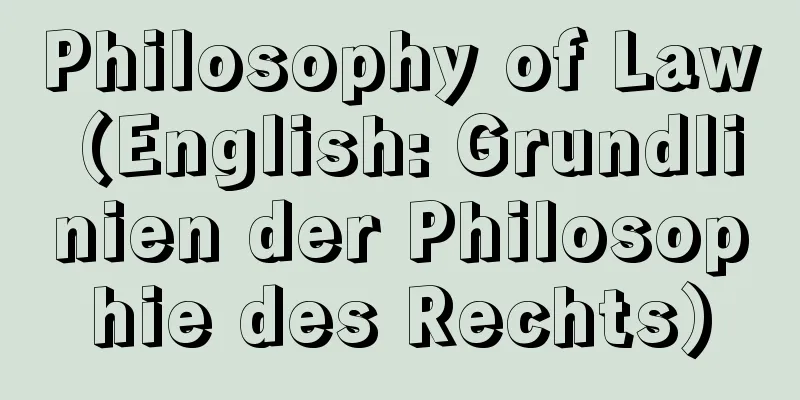Colloid - Colloid (English spelling)

|
A state in which a certain substance is dispersed in another substance as particles of a specific size range (about 0.1 micrometers). The name colloid comes from the Greek word κολλα (kolla, glue). For this reason, in Japan, it was previously called "koushitsu" (gelatinous). Originally, the concept was proposed in 1861 by the British scientist Graham as a way to distinguish crystalline substances such as salt and sugar from non-crystalline substances such as gelatin, starch, and proteins, and he named the former as crystalloids and the latter as colloids. Many of the colloid-related terms we use today were created by Graham. However, subsequent research has revealed that starch and proteins can also crystallize, and that the properties of colloids are more influenced by factors such as particle size than by whether they are crystalline or not. Graham made this classification because he discovered that the speed of diffusion in an aqueous solution differs greatly between aqueous solutions of salt, sucrose, hydrochloric acid, etc. and those of glue, starch, proteins, etc. When an aqueous solution containing both of these is placed in contact with pure water, separated by a piece of parchment paper or a bladder membrane, colloids cannot pass through the membrane, but crystalloids can move and diffuse toward the pure water, allowing them to be separated. This is called dialysis. However, as colloid chemistry has developed since then, the concept of colloids has expanded, and crystalloids have become less prominent. Colloids are often considered to include membranes and fibers with thicknesses of 1 to 100 nanometers. These are called two-dimensional colloids and one-dimensional colloids, respectively. Furthermore, when the molecules themselves are on the order of nanometers in size, solutions of such substances exhibit the properties of a colloid, even though they are molecular solutions. In other words, they are colloidal dispersion systems. Solutions of starch, proteins, and polymeric substances are perfect examples of this, and these are collectively called molecular colloids or true colloids. [Yamazaki Akira] Dispersoids and Dispersion MediaA liquid in which colloidal particles are dispersed (not dissolved) is called a colloidal solution, the substance of the dispersed particles is called the dispersoid (sometimes called the dispersed phase), and the medium of dispersion is called the dispersion medium. These correspond to the solute and solvent in a solution. In a starch solution, for example, starch is the dispersoid and water is the dispersion medium. [Yamazaki Akira] Classification of colloidsSome combinations of dispersoids and dispersion media are given specific names. We can see that there are many examples of colloids around us, such as food, daily necessities, household products, and more. They can also be classified according to the state of aggregation of the dispersoids. (1) Micellar colloid (association colloid): Micelles formed when several to several tens of molecules associate in a solution are dispersed as colloidal particles, such as those found in surfactants, soaps, and dyes. (2) Molecular colloids Natural polymers such as starch and proteins, and synthetic polymers such as nylon and polyvinyl chloride, each molecule has a size equivalent to that of a colloidal particle. Therefore, even if the molecules are dispersed like in a true solution, they exhibit the properties of a colloidal solution. (3) Particle colloids These are solid particles or microcrystals dispersed as colloidal particles, such as iron hydroxide, arsenic sulfide, or gold sol (Cassius' purple). Furthermore, they are often classified according to the affinity between the dispersoid and the dispersion medium. Colloids with a high affinity between the dispersoid and the dispersion medium are called lyophilic colloids, and those with a low affinity are called lyophobic colloids. For water and oil, there are hydrophilic colloids, hydrophobic colloids, lipophilic colloids, and lipophobic colloids, respectively. (1) Hydrophilic colloids: Among sols (hydrosols) that use water as a dispersion medium, hydrocolloids are those in which the dispersed matter has a high affinity for water. Polymer electrolytes such as starch and albumin, or micelles made from surfactants, are classified as hydrophilic colloids. They do not easily coagulate when a small amount of electrolyte is added, but coagulation occurs when alcohol or a large amount of electrolyte is added (for example, tofu). The Tyndall phenomenon is also less visible than with hydrophobic colloids, and in many cases the particles are difficult to see even with an ultramicroscope. Their surface tension is generally lower than that of water, and their viscosity tends to be higher than that of water. (2) Hydrophobic colloids: A type of colloid that uses water as a dispersion medium and easily aggregates and precipitates when a small amount of electrolyte is added. They generally exhibit a strong Tyndall effect. Many inorganic colloids, such as metal particles and metal sulfides, are hydrophobic colloids. The particles can be easily observed with an ultramicroscope. [Yamazaki Akira] Properties of colloidal solutionsWhen a colloidal dispersion is irradiated with a beam of light and viewed from the side, the path of the light appears to shine brightly. This is called the Tyndall phenomenon or Tyndall effect. It is the scattering of light by colloidal particles. Colloidal particles cannot be seen under a microscope as they are, but their Brownian motion can be observed using an ultramicroscope. Colloidal particles generally carry an electric charge, and when electrodes are inserted and a direct current voltage is applied, they move toward the opposite electrode according to their respective electric charges (electrophoresis). Colloidal particles are stably dispersed in a solution because they repel each other due to their electric charges of the same sign. However, when ions with an opposite electric charge are added, the attractive forces between the colloidal particles exceed the repulsive forces between them, and they begin to aggregate, sometimes resulting in precipitation. This is called coagulation (flocculation). The more polyvalent the ion, the greater its coagulation ability. Magnesium chloride or calcium sulfate is added when making tofu, taking advantage of the fact that they effectively coagulate even at much lower concentrations than monovalent ions. The addition of aluminum sulfate or alum in wastewater treatment also takes advantage of the coagulation caused by aluminum ions. Coagulation that occurs when polymer electrolytes are added is much more noticeable because the valence of the ions is large. If loaches are released into a suspension of bentonite, coagulation occurs due to the polymer electrolytes in the mucus secreted from the epidermis, and the water becomes clear. Colloid titration is the application of this principle to quantitative analysis. It was invented in 1948 (Showa 23) by Terayama Hiroshi of the University of Tokyo, but initially it was difficult to obtain suitable reagents and it did not receive due acclaim. However, in recent years it has become a convenient method that has spread worldwide. In colloidal solutions, hydrophilic colloids are sometimes added to prevent the hydrophobic colloids from coagulating, which makes the dispersion stable. The hydrophilic colloids added in this case are called protective colloids. [Yamazaki Akira] How to make a colloidal solutionSolutions of macromolecules, that is, molecular colloid solutions, can be easily made by slowly heating an appropriate solvent. There are many examples of molecular colloids made in the kitchen, such as starch, gelatin, and agar. Lyophobic colloids and micellar colloids are a little more difficult to make. Micellar colloids are produced by carefully preparing a solution of surfactants, soap, etc., so that the solution is above the critical micelle concentration (CMC). Metal colloids can be prepared physically, by discharging electricity in water to create fine particles, or by dispersing with ultrasound, or chemically by creating fine particles through reduction. Cassius' purple, a gold colloid mentioned earlier, utilizes reduction with tin(II) chloride. Mercury sulfide and aluminum hydroxide can be prepared using ultrasonic dispersion. Also, if the precipitate collected on a filter paper is washed with hot water, a colloidal solution is created by peptization. Iron(III) hydroxide colloids are often made this way, but when performing gravimetric analysis, the precipitate is washed with a washing solution containing an electrolyte such as ammonium nitrate to prevent peptization. Iron hydroxide colloids can also be obtained by diluting a concentrated solution of iron(III) chloride with hot water, or by heating a dilute aqueous solution. "Yunohana" (sparkle) sold at hot springs is made by collecting and solidifying sulfur colloids produced by the oxidation of hydrogen sulfide. It is used in baths, medicines, and cosmetics. In any case, various impurities will be mixed into the colloidal solution to a greater or lesser extent. Large particles can be removed by filtering through filter paper, but ionic impurities can be removed by dialysis, as mentioned earlier. If the colloidal solution is placed in a bag made of cellophane or other material and the outside of the bag is washed with new dispersion medium (such as water), low molecular weight impurities will pass through the membrane, but the colloidal particles will remain inside the membrane, making it possible to purify the solution. Dialysis can be carried out much more quickly if a direct current voltage is applied to the outside, utilizing the movement of ions caused by the electric field. However, care must be taken, as with some colloids, excessive purification can cause the charge on the particles to come off, making them unstable. [Yamazaki Akira] "Easy Science of Colloids and Interfaces" by Tamotsu Kondo and Shiro Suzuki (1983, Sankyo Publishing) "Fundamentals of Colloid Chemistry" by Masayuki Nakagaki and Kiyonari Fukuda (1968, Dainippon Tosho) [References] |©Shogakukan "> Colloidal solutions (dispersoids and dispersion media) A ray of light passing through salt water is scattered by the sulfur colloidal solution on the right (photo). The greater the difference in the refractive index of the colloidal particles and the dispersion medium, the more pronounced the scattering effect . Properties of colloidal solutions - Tyndall phenomenon Using an ultramicroscope, we can see colloidal particles undergoing Brownian motion, similar to the movement of dust particles in the air. This phenomenon occurs as a result of collisions between colloidal particles and the random thermal motion of solvent molecules . Properties of colloidal solutions - Brownian motion This occurs because colloidal particles are positively or negatively charged. Generally, metal oxides and hydroxides are positively charged, and sulfides are negatively charged . Properties of colloidal solutions - electrophoresis Source: Shogakukan Encyclopedia Nipponica About Encyclopedia Nipponica Information | Legend |
|
ある物質が特定の範囲の大きさ(0.1マイクロメートル程度)の粒子となって他の物質の中に分散している状態をいう。コロイドという名称は、ギリシア語のκολλα(kolla、膠(にかわ))に由来している。そのために日本では以前、膠質(こうしつ)といったことがある。 本来は、食塩や砂糖のような結晶性物質と、ゼラチンやデンプン、タンパク質などのような非結晶性物質を分けるための概念として、イギリスのグレアムが1861年に提唱したものであり、前者をクリスタロイド(晶質)、後者をコロイド(膠質)と名づけたのが始まりである。今日われわれの用いるコロイド関係の用語の多くは、グレアムによって制定されたものが少なくない。しかしその後の研究によって、デンプンやタンパク質も結晶することがわかり、コロイドの性質は、結晶性であるかどうかより、粒子の大きさなどのほうが大きく影響することがわかってきた。 グレアムがこのような分類を行ったのは、水溶液の中における拡散の速度が、食塩やショ糖、塩酸などの水溶液と、膠やデンプン、タンパク質などの水溶液とでは、大きな差があることを発見したからである。この両方を含む水溶液と純水とを、硫酸紙あるいは膀胱(ぼうこう)膜などを隔てて接触させると、コロイドはこの膜を透過できないが、クリスタロイドのほうは純水の方向へ移動・拡散していくので分離できる。これを透析という。しかし、その後コロイド化学の発展につれて、コロイドの概念は拡張され、クリスタロイドのほうは影が薄くなってしまった。 コロイドのなかには、厚さや太さが1~100ナノメートルの膜や繊維までをも含めて取り扱うことが多い。これらはそれぞれに、二次元コロイド、一次元コロイドという。さらに分子自体がナノメートルの桁(けた)の大きさのものになると、このような物質の溶液は、分子溶液であるのにコロイドとしての性質を示すことになる。つまりコロイド分散系である。デンプンやタンパク質、高分子物質の溶液はまさにこのような場合であり、これらを総称して分子コロイドまたは真正コロイドという。 [山崎 昶] 分散質と分散媒コロイド粒子が分散している(溶解しているとはいわない)液体をコロイド溶液というが、分散している粒子の物質を分散質(分散相ということもある)、分散の媒体を分散媒という。これは溶液における溶質と溶媒に対応している。デンプン溶液などでは、デンプンが分散質、水が分散媒となる。 [山崎 昶] コロイドの分類分散質と分散媒の組合せによっては、特定の呼称がつけられているものがある。われわれの身の周りには食品、日用品、家庭用品その他多数のコロイドの実例が存在していることがわかる。また、分散質の集合状態によっても分類できる。 (1)ミセルコロイド(会合コロイド) 界面活性剤、せっけん、染料などのように、溶液の中で分子が数個から数十個会合して生じたミセルがコロイド粒子として分散しているもの。 (2)分子コロイド デンプン、タンパク質などの天然高分子や、ナイロン、塩化ビニルなどの合成高分子は、それだけで(分子1個で)コロイド粒子相当の大きさをもっている。したがって真の溶液のように分子分散をしていても、コロイド溶液としての性質が現れる。 (3)粒子コロイド 水酸化鉄や硫化ヒ素、あるいは金のゾル(カシウスの紫)などのように固体粒子や微結晶がコロイド粒子として分散しているものである。 さらに、分散質と分散媒の親和性によって分類することもしばしば行われている。分散質と分散媒相互に親和性の大のものを親液コロイド、小のものを疎液コロイドという。水と油に対して、それぞれ親水コロイド、疎水コロイド、親油コロイド、疎油コロイドが存在する。 (1)親水コロイド 水を分散媒とするゾル(ヒドロゾル)のうちで、分散質が水との親和性に富むものをいう。デンプン、アルブミンなどの高分子電解質、あるいは界面活性剤からなるミセルなどはこの親水コロイドに区分される。少量の電解質を加えても簡単には凝結をおこさないが、アルコールとか、かなり大量の電解質を加えると凝結がおこる(たとえば豆腐など)。チンダル現象も疎水コロイドに比べて見えにくく、限外顕微鏡によっても粒子が認めがたいものが多い。表面張力は概して水より小、粘性率は水より大の傾向がある。 (2)疎水コロイド 水を分散媒とするコロイドのうち、ごく少量の電解質を加えるだけで容易に凝集、沈殿を生じるもの。一般に強いチンダル現象を示す。金属粒子や金属の硫化物などの無機物のコロイドの多くはこの疎水コロイドである。限外顕微鏡で容易に粒子を観察できる。 [山崎 昶] コロイド溶液の性質コロイド分散系に光束を当てて側面から見ると、光の通路が鮮やかに光って見える。これをチンダル現象またはチンダル効果という。コロイド粒子による光の散乱である。コロイド粒子はそのままでは顕微鏡で見ることはできないが、限外顕微鏡によって粒子のブラウン運動を観察することができる。コロイド粒子は一般に電荷を保持していて、電極を入れて直流電圧を加えると、それぞれの電荷に応じて反対側の電極のほうへ移動する(電気泳動)。コロイド粒子は同符号の電荷をもっているために、互いに反発しているから溶液中に安定に分散しているのだが、これと反対符号の電荷をもつイオンを加えると、コロイド粒子間の反発力よりも引力がまさって凝集が始まり、ときには沈殿を生じる。これを凝析(凝結)という。凝析能力は多価のイオンほど大であり、豆腐をつくる際に塩化マグネシウムや硫酸カルシウムを加えるのは、これらが1価のイオンよりずっと低濃度でも有効に凝析をおこすことを利用している。廃水処理などで硫酸アルミニウムやミョウバンなどを添加するのも、アルミニウムイオンによる凝析の利用である。 高分子の電解質を加えた際におこる凝析は、イオンの価数が大きいためにずっと顕著である。ベントナイトの懸濁液にドジョウを放すと、表皮から分泌される粘液の中の高分子電解質のために凝析がおこり水は清澄になる。この原理を定量分析に応用したのがコロイド滴定である。東京大学の寺山宏(てらやまひろし)により1948年(昭和23)に創案されたが、当初は好適な試薬が得がたかったこともあり、なかなか正当な評価を得られなかったが、近年、世界的に普及した便利な方法となった。 コロイド溶液において、疎水コロイドが凝結するのを防ぐために親水コロイドを加えることがある。このようにすると分散系は安定になるが、この際に加える親水コロイドを保護コロイドという。 [山崎 昶] コロイド溶液のつくり方巨大分子の溶液、すなわち分子コロイド溶液をつくるには、適当な溶媒を選んでゆっくり温めることにより簡単に可能となる。デンプンやゼラチン、寒天など台所で実際につくっている例には事欠かない。疎液コロイドやミセルコロイドをつくるには、これよりも多少むずかしい。ミセルコロイドは、界面活性剤、せっけんなどを臨界ミセル濃度(CMC)以上となるように注意して溶液をつくると生じる。金属のコロイドは、水中で放電により微粒子をつくらせたり、超音波で分散させたりして物理的に調整する方法と、化学的に還元によって微粒子をつくらせる方法がある。前にもあげた金のコロイドであるカシウスの紫は、塩化スズ(Ⅱ)による還元を利用している。硫化水銀や水酸化アルミニウムなどは超音波分散法で調製できる。 また、濾紙(ろし)上に集めた沈殿を熱水で洗うと、解膠(かいこう)(ペプチゼーション)によってコロイド溶液がつくられる。水酸化鉄(Ⅲ)のコロイドはよくこの方法でつくられるが、重量分析などに際しては解膠がおきないように、硝酸アンモニウムなどの電解質を溶かした洗液で沈殿を洗うことになっている。水酸化鉄のコロイドは、塩化鉄(Ⅲ)の濃厚溶液を熱水で希釈しても得られるし、希薄水溶液を加熱してもよい。温泉場などで売っている「湯の華(はな)」は硫化水素の酸化によって生じた硫黄(いおう)のコロイドを集めて固めたものである。浴用、薬用、化粧品として用いられる。 いずれにせよコロイド溶液には多かれ少なかれ種々の不純物が混入してくる。粒の大きいものは濾紙で濾過して除けるが、イオン性の不純物を除くには、前にも述べた透析による。セロファン膜などの袋にコロイド溶液を入れて、袋の外側を新しい分散媒(水など)で洗うと、低分子のものは膜を透過するが、コロイド粒子は膜の内側に残るので精製できる。外側に直流電圧をかけて電場によるイオンの移動を利用すると、ずっと迅速に透析ができる。もっとも、コロイドによっては、あまり精製すると粒子上の電荷まで外れてしまい不安定となるものもあるので注意が必要である。 [山崎 昶] 『近藤保・鈴木四朗著『やさしいコロイドと界面の科学』(1983・三共出版)』▽『中垣正幸・福田清成著『コロイド化学の基礎』(1968・大日本図書)』 [参照項目] |©Shogakukan"> コロイド溶液(分散質と分散媒) 食塩水を通った光線は、右側の硫黄のコロイド溶液で散乱される(写真)。コロイド粒子と分散媒の光の屈折率の差が大きいほど著しい©Shogakukan"> コロイド溶液の性質―チンダル現象 限外顕微鏡を使うと、空中のごみが動くようにコロイド粒子がブラウン運動をするようすが見える。これは、コロイド粒子と溶媒分子の不規則な熱運動の衝突の結果おこる現象である©Shogakukan"> コロイド溶液の性質―ブラウン運動 コロイド粒子が正または負に荷電しているためにおこる。一般に金属の酸化物、水酸化物は正に、硫化物は負に荷電している©Shogakukan"> コロイド溶液の性質―電気泳動 出典 小学館 日本大百科全書(ニッポニカ)日本大百科全書(ニッポニカ)について 情報 | 凡例 |
<<: Colloid Chemistry - Colloid Science
Recommend
Okuragumi Shokai - Okuragumi Introduction
…He opened a gun shop on Kanda Izumibashi-dori in...
Ishizukayama Kofun
<br /> This ancient tomb is located in Tomih...
Kagoshima Space Center - Kagoshima Space Center
Please see the Uchinoura Space Center page. Sourc...
Roger Garaudy
1913‐ French philosopher. Studied at the Sorbonne....
Kiritsukemono - Cut-out crest
〘 noun 〙 A crest is a pattern made by cutting out ...
baker's itch
…Acarid mites are not only pests that infest food...
Shofar (English spelling)
The ancient Israelite horn, made from the horns of...
Neapolis (Soviet Union) (English spelling)
...It serves as a transportation hub for the Crim...
Saturation of nuclear forces
...In other words, a nucleon does not exert nucle...
Mystery novel - Suiri Shosetsu
Currently, the terms detective story and mystery ...
Higanbana (red spider lily) - Lycoris radiata
A perennial plant of the Amaryllidaceae family, al...
《Grundlegung der Lehre vom sozualen Verband》 (English notation) GrundlegungderLehrevomsozualenVerband
…[Junichi Aoi]. . … *Some of the terminology expl...
Hayato
Located in the northeastern part of Kagoshima Pref...
Narke japonica (English spelling) Narkejaponica
...The Japanese name comes from the fact that it ...
Song of the thread
...A labor song sung during the work of spinning ...









